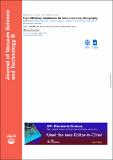| dc.contributor.author | Smith, Henry I | |
| dc.contributor.author | Mondol, Mark | |
| dc.contributor.author | Zhang, Feng | |
| dc.contributor.author | Savas, Timothy | |
| dc.contributor.author | Walsh, Michael | |
| dc.date.accessioned | 2024-09-19T15:43:49Z | |
| dc.date.available | 2024-09-19T15:43:49Z | |
| dc.date.issued | 2023-12-01 | |
| dc.identifier.uri | https://hdl.handle.net/1721.1/156905 | |
| dc.description.abstract | To date, zone-plate-array lithography has employed an array of binary pi-phase zone plates, each 135 μm in diameter, operating at 405 nm wavelength, in conjunction with a spatial-light modulator and a moving stage, to expose large-area patterns in photoresist without a mask. Although the low focal efficiency (<34%) and high background (>66%) of such zone plates can be mitigated via proximity-effect correction, increased focal efficiency would enable higher quality patterning. To that end, we have designed flat, diffractive-optical “metalenses.” Each is first divided into Fresnel zones, across which the effective index-of-refraction is modulated by forming appropriate pillars or holes such that diffracted beams interfere constructively at the focal spot, located 100 μm in front of the lens plane. The diffraction efficiency of each zone is simulated using rigorous-coupled-wave analysis. A genetic algorithm is then used to determine if higher efficiency can be achieved by repositioning of the pillars or modifying their widths. MEEP software is used to predict focal efficiency of the completed metalens design. Scanning-electron-beam lithography was used to fabricate effective-index-modulated metalenses in CSAR-62 e-beam resist. In some cases, the focal properties and efficiencies of such structures were measured, yielding focal efficiencies up to 54%. In other cases, the e-beam-written pattern was transferred into a spin-on hard mask and then into an organic dielectric of 1.9 index of refraction using reactive ion etching. Focal efficiencies up to 69% are predicted for such structures, a significant improvement over the binary pi-phase zone plates used previously. | en_US |
| dc.language.iso | en | |
| dc.publisher | American Vacuum Society | en_US |
| dc.relation.isversionof | 10.1116/6.0003024 | en_US |
| dc.rights | Creative Commons Attribution | en_US |
| dc.rights.uri | https://creativecommons.org/licenses/by/4.0/ | en_US |
| dc.source | AIP Publishing | en_US |
| dc.title | High-efficiency metalenses for zone-plate-array lithography | en_US |
| dc.type | Article | en_US |
| dc.identifier.citation | Henry I. Smith, Mark Mondol, Feng Zhang, Timothy Savas, Michael Walsh; High-efficiency metalenses for zone-plate-array lithography. J. Vac. Sci. Technol. B 1 November 2023; 41 (6): 062601. | en_US |
| dc.contributor.department | MIT.nano | en_US |
| dc.relation.journal | Journal of Vacuum Science & Technology B | en_US |
| dc.eprint.version | Final published version | en_US |
| dc.type.uri | http://purl.org/eprint/type/JournalArticle | en_US |
| eprint.status | http://purl.org/eprint/status/PeerReviewed | en_US |
| dc.date.updated | 2024-09-19T15:35:33Z | |
| dspace.orderedauthors | Smith, HI; Mondol, M; Zhang, F; Savas, T; Walsh, M | en_US |
| dspace.date.submission | 2024-09-19T15:35:35Z | |
| mit.journal.volume | 41 | en_US |
| mit.journal.issue | 6 | en_US |
| mit.license | PUBLISHER_CC | |
| mit.metadata.status | Authority Work and Publication Information Needed | en_US |
